Translation Analysis in Sentence Patterns Found in the “Good Earth”
on
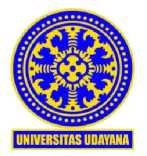
e-Journal of Linguistics
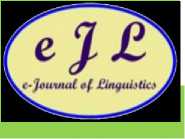
Available online at https://ojs.unud.ac.id/index.php/eol/index
Vol. 17, No. 2, July 2023, pages: 230--240
Print ISSN: 2541-5514 Online ISSN: 2442-7586
https://doi.org/10.24843/e-jl.2023.v17.i02.p12
Translation Analysis in Sentence Patterns Found in the “Good Earth”
I Made Juliarta
Program Studi Bahasa Inggris, Universitas Bali Dwipa, Denpasar Email: madejuliarta330@gmail.com
Article info
Received Date: 27 Desember 2022
Accepted Date: 25 February 2023
Published Date: 31 July 2023
Keywords: Sentence pattern, complex sentence, translation shift
Abstract
This study aims to: (i) analyze the tree diagram structure of sentence patterns found in the novel “The Good Earth”, (ii) analyze the types of translation shifts in sentence patterns in the translation process that were found in the data source. The novel entitled “The Good Earth” is a famous literary work that was written by Pearl S. Buck. It told about family life in a village in China before the world war I. This novel was the best seller at that time. This research focuses on The Syntax Analysis and Its Translation Found on Sentence Patterns in the story from novel entitled “The Good earth”. This study also focuses on analyzing the tree diagram structure and the types of translation shifts in translating from the source language into target language. The analysis applied the theory of sentence patterns that was proposed by Quirk and Greenbaum and the theory of translations shift proposed by Catford. The process of collecting data was started by reading the novel in order to understand the novel entitled “The Good Earth” and observe the data of sentence patterns that could be taken from the data source. In the method of collecting data, the novel was read in order to find out data of complex sentences and simple sentence that were found in the novel.
The “Good Earth” was the story telling about the life of Wang Lung’s family who was very poor at that time. The House of Hwang a family of wealthy landowners lived in the nearby town. However, Wang Lung's future wife O-Lan lived as a slave in a village. Lung and his family then moved into a town and rent the old House of Hwang. Wang Lung wanted peace but there were always disputes, especially between his first and second sons, and particularly their wife. The researcher was interested in analyzing sentence patterns and the translations of shifts that were found in the data source. This novel was chosen as the data source by the researcher as it was the best seller novel and some data related to sentence patterns were found. The novel was in English-Indonesian version that enabled the researcher to analyze the translations shift occured in translating from the source language into target language.
Subject, verb, complement, object and adverbial are part of the sentence. People used language in order to express their feeling, ideas, knowledge and thought and as the main instrument of communication. Therefore, it can not be separated from human being. Moreover, language is important to use as the way to express our feeling, respond the phenomena, share an idea, and criticize as well. Language has an important role as a mean of communication in daily life and doing interactions with each other. Language can be used as the media in doing communication with other people either in oral or written forms. Syntax can be used as the arrangement and relationship among words, phrases, and clauses that form sentences or larger
constructions based on grammatical rules. The set of rules, principles, and process that govern the structure of sentences are called as syntax in linguistics. Subject, verb, and object can be found in a sentence.
Sapir (1921) stated that the language is used as “a purely human and non-instinctive method of communicating ideas, emotions and desires by means of a system. In a simple sentence, there are a subject and a verb. Moreover, Radford (1997) stated that syntax focuses on how words can be put together in order to form phrases and sentences. Syntactic patterns, syntactic construction, and system of rules are usually used to discuss in the syntax. Knowledge can be developed and know something by using language. Based on the phenomena, the researcher chooses the novel entitled “The Good Earth” as the data source because it contains few patterns that are analyzed syntactically. The researcher is interested in doing the research as there were some sentence patterns and translation shift found in the novel entitled “The Good Earth”. By doing this research, the researcher hopes that the reader gets the point and deeper information about syntactic analysis on sentence patterns and translation shift that were found in the novel entitled “The Good Earth”. Simple sentence and their translations found in the story entitled “The Good Earth” were analyzed by the researcher. The theory that was proposed by Catford (1965) was applied by the researcher in the translation analysis in analyzing about the shift in translation found in the novel “The Good Earth”. The theory of syntax and translation were chosen to analyze the data source as it gives deeper analysis related to the translation analysis discussed in this research study. Nouns, pronouns, verbs, adjective, adverbs, prepositions, and articles or determiners are then classified as English words. Morevover, Chaer and Agustina (2010:1) stated that there are two types in the factor of languages. In external factors, language has been related to other contexts. It had been seen from the various functions of language and the social situation.
There are two reasons why the researcher chose sentence patterns and their translations as the object of this research, they are as follows: (1) examining the pattern of the sentence containing in the novel “The Good Earth”; (2) analyzing the sentence patterns by using tree diagram found in “The Good Earth”. Previous related studies on the sentence patterns were reviewed as the literary reviews. First study was written by Rahmawati (2003) entitled “A Syntactical Analysis on Sentence Patterns Used in David Forester’s Songs”. There were nineteen rules of the sentence patterns with Noun Phrase and Verb Phrase as the most common rules which were analyzed in this research study. Other common sentence patterns that consist of Noun Phrase, Verb Phrase, Preposition, Conjunction plus Verb Phrase or Noun Phrase were also analyzed in this research study. Finally, this research study stated that kernel sentences appear less than the transformed ones. The second research was written by Yulia, in her thesis (1998) entitled “Sentence Patterns Used in Michael Learns to Rock’s Pop Songs”. This research study stated that kernel sentence mostly appears rather than transformed sentences. The sentences are in the form of VP, simple sentence or two sentences that were combined with or without conjunction. This research study analyzed the substandard English words such as ‘bout, I’m, she’s, and I’ve.
In the method and technique of collecting data of sentence patterns, this study applied observation and documentary analysis. The observation method was applied in this study in order to observe the entire data that contained sentence patterns in the source language and their translations in the target language found in the novel entitled “The Good Earth”. The techniques of collecting data of sentence patterns in the novel “The Good Earth” were used by doing note taking, reading and doing observation. In the process of collecting the data of sentence patterns, the data were read to know the story that was found in the data source and it was continued to observe the possibility of the data that were taken from data source. First, the entire story of the
novel “The Good earth” were read to get the data of sentence patterns and analyzed the syntactic structure by using tree diagram by using the theory that were proposed by Brown and Miller. After that, the researcher continued to get the data of sentence patterns based on the problems discussed in this research study. The sentence patterns found in the data source and its syntactic structure were analyzed by using the tree diagrams. Finally, it was continued to analyze the types of translation shifts of relative clauses occurred in the translation of the novel entitled “The Good Earth”. Sentence patterns are stated as the way to build sentences. Structure categories of each lexical item were classified by sentence patterns. Tree diagram is used to analyse the internal structure of words and phrases in sentence patterns found in the data source. O’Grady, Dobrovolsky, and Katamba’s (1996, p. 734) stated that the diagram “represents the details of a word or phrase’s internal structure”. Moreover, according to Radford (1997, p. 533) tree diagram is “a way of representing the syntactic structure of a phrase or sentence. The tree diagram can be used as a suitable means of showing the internal structure of sentences.
Phrase structure explains about how the word can be built up the phrase and how the sentences can be structured out of phrase. It can be seen in the following rules. The example of phrase structure rules is described in constituent structure as follows:
S ----------H X Y
The constituent structure is placed on left side. The components can be seen on the right side. The structure rules explain that the sentence consists of noun phrase and verb phrase. X and Y consist of two constituents of S. There are some forms of phrasal categories, for example PP, AP, NP, VP, ADVP. A set of elements forming a constituent can be called as phrase. There is a head noun in noun phrase.
Datum 1
It was a good omen. (1)
Pertanda baik. (6)

NP
Pro
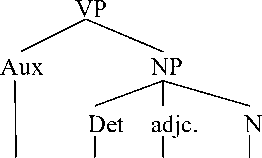
It was a good omen
It can be seen from the structure in the simple sentence It was a good omen that the simple sentence has the constituent structure of NP and VP. The VP consists of auxiliary and noun phrase. We can see from the structure as follows:
S-------► NP VP
VP -------► auxiliary NP
It can be seen from the constituent structure in sentence pattern in datum 1 that structure shift occured in the translation proccess as there is a change of the position of word structure in both languages without changing the meaning of the message in the source language. As a part of simple sentence pattern, a good omen in the source language was translated into pertanda baik in the target language. It can be seen from the translation of a good omen which is constructed by modifier (adjective, a good) + head (noun, omen) and translated into head (noun, pertanda) + modifier (adjective, baik). Therefore, there is change of the position of word structure a good omen into pertanda baik without changing the meaning of the message of the source language.
Datum 2
The fields needed rain for fruition. (1)
Memang sawah membutuhkan air supaya padi dapat tumbuh. (6)
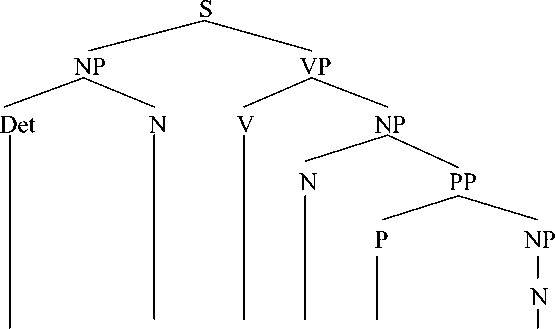
The fields needed rain for
fruition
It can be seen from the structure in the sentence The fields needed rain for fruition that the simple sentence has the constituent structure of NP and VP. The VP consists of verb, noun phrase and prepositional phrase. We can see the constituent structure in datum 2 as follows:
S------► NP VP
VP ------► Verb NP PP
By looking at the tree diagram in datum 2 in the sentence The fields needed rain for fruition, it can be seen from the text that unit shift occurred in the process of translation. A translation shift of a word into a phrase occurred in the translation process in datum 2. As a part of simple sentence, a word fruition was translated into a phrase padi dapat tumbuh. The translation equivalent in the target language occurs at a different rank into a phrase padi dapat tumbuh. This type of shift is called as unit shift that is a change in higher rank translated from a noun fruition into a phrase padi dapat tumbuh.
Datum 3
Yesterday he had said to his father. (1)
Kemarin ia mengatakan pada ayahnya. (6)
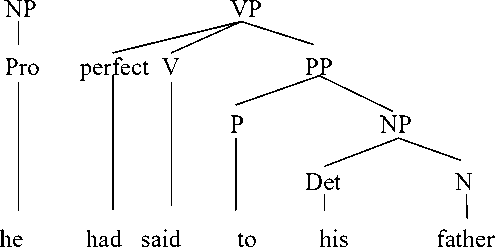
Yesterday

ADV
It can be seen from the structure in simple sentence in datum 3 Yesterday he had said to his father that the simple sentence has the constituent structure of ADVP, NP, and VP. The VP consists of perfect, verb, noun phrase and prepositional phrase. We can see the constituent structure in datum 3 as follows:
S------► ADVP S
S ------► NP VP
VP ------► Perfect V PP
By looking at the tree diagram in datum 3 in the sentence Yesterday he had said to his father, it can be seen from the text that unit shift occurred in the process of translation. A translation shift of a phrase into a word occurred in the translation process in datum 3. As a part of simple sentence, a phrase had said was translated into a word mengatakan. The translation equivalent in the target language occurs at a different rank into a word mengatakan. This type of shift is called as unit shift that is a change in lower rank that was translated from a phrase had said into a word mengatakan.
Datum 4
He went into the shed. (1)
Ia melangkah lagi ke ruangan. (6)
S
NP
VP
Pro
V
PP
P
NP

Art
N
He
went
We
into
can see
the
shed
from the structure in simple sentence in datum 4 he went into the shed that the
simple sentence has the constituent structure of NP and VP. The VP consists of verb, prepositional phrase and noun phrase. We can see the constituent structure in datum 4 as follows:
S
♦ NP VP
VP -----► V PP
PP ------► P NP
By looking at the tree diagram in datum 4 in the sentence he went into the shed, it can be seen from the text that unit shift occurred in the process of translation. A translation shift of a phrase into a phrase occurred in the translation process in datum 4. As a part of simple sentence, a phrase the shed was translated into a word ruangan. The translation equivalent in the target language occurs at a different rank into a word ruangan. This type of shift is called as unit shift that is a change in lower rank that was translated from a phrase the shed into a word ruangan. Unist translation shift in higher rank also occured in translating a word went into a phrase melangkah lagi.
Datum 5
The old man's eyes opened greedily. (2)
Mata orang tua itu terbuka lebar-lebar. (9)

ADV
NP VP

The old man’s eyes opened
greedily
It can be seen from the structure in sentence pattern in datum 5 the old man's eyes opened greedily that the simple sentence has the constituent structure of NP, VP and ADVP. The VP consists of verb only. We can see from the constituent structure of the old man's eyes opened greedily in datum 5 as follows:
S------► S ADVP
S -----► NP VP
ADVP -----► ADV
By looking at the tree diagram in datum 5 in the sentence the old man's eyes opened greedily, it can be seen from the text that unit shift occurred in the process of translation. A translation shift of a word into a phrase occurred in the translation process in datum 5. As a part of simple sentence, an adverb greedily was translated into a phrase lebar-lebar. The translation equivalent in the target language occurs at a different rank into a phrase lebar-lebar. This type of shift is called as unit shift that is a change in higher rank that was translated from an adverb greedily into a phrase lebar-lebar. Unit translation shift in higher rank also occured in translating an adverb greedily into a phrase lebar-lebar. Structure shift also occured in datum 5 in the translation proccess as there is a change of the position of word structure in both languages without changing the meaning of the message in the source language. As a part of simple sentence pattern, old man’s eyes in the source language were translated into mata orang tua in the target language. It can be seen from the translation of old man’s eyes which is constructed by modifier (adjective, old) + head (noun, man’s eyes) and it was translated into head (noun, mata orang) + modifier (adjective, tua). Therefore, there is change of the position of word structure old man’s eyes into mata orang tua without changing the meaning of the message of the source language.
Datum 6
The old man continued to cough perseveringly. (2)
Batuk orang tua itu terdengar makin lama makin menjadi. (9)
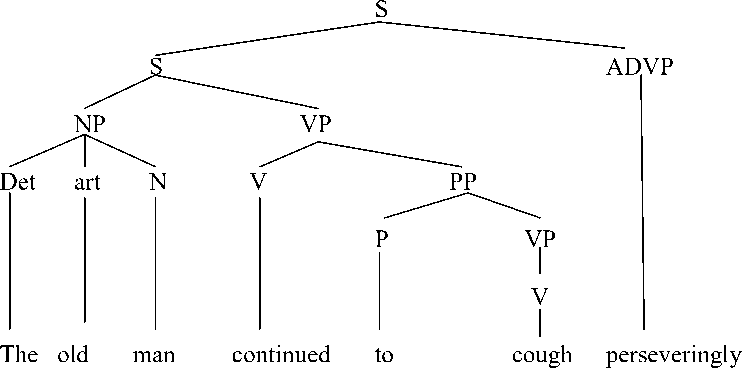
It can be seen from the structure in sentence pattern in datum 6 The old man continued to cough perseveringly that the simple sentence has the constituent structure of NP, VP and ADVP. The VP consists of verb only. We can see from the constituent structure of the old man's eyes opened greedily in datum 5 as follows: S------► S ADVP
S -----► NP VP
ADVP -----► ADV
By looking at the tree diagram in datum 6 in the sentence the old man continued to cough perseveringly it can be seen from the text that unit shift occurred in the process of translation. A translation shift of a word into a phrase occurred in the translation process in datum 6. As a part of simple sentence, an adverb perseveringly was translated into a phrase makin lama makin menjadi. The translation equivalent in the target language occurs at a different rank into a phrase makin lama
makin menjadi. This type of shift is called as unit shift that is a change in higher rank that was translated from an adverb perseveringly into a phrase makin lama makin menjadi. It can be seen that structure shift also occured in datum 6 in the translation proccess as there is a change of the position of word structure in both languages without changing the meaning of the message in the source language. As a part of simple sentence pattern, old man in the source language was translated into orang tua in the target language. It can be seen from the translation of old man which is constructed by modifier (adjective, old) + head (noun, man) and it was translated into head (noun, orang) + modifier (adjective, tua). Therefore, there is change of the position of word structure old man into orang tua without changing the meaning of the message of the source language.
Datum 7
This simple question troubled Wang Lung. (13)
Pertanyaan sederhana itu membingungkan Wang Lung. (37)
S
NP VP
V NP
N
This simple question troubled Wang Lung
It can be seen from the structure in sentence pattern in datum 7 this simple question troubled Wang Lung that the simple sentence has the constituent structure of NP and VP. The VP consists of verb and Noun Phrase. We can see from the constituent structure of this simple question troubled Wang Lung in datum 7 as follows:
S-------► NP VP
VP -----► V NP
Structure shift also occured in datum 7 in the translation proccess as there is a change of the position of word structure in both languages without changing the meaning of the message in the source language. As a part of simple sentence pattern in datum 7, this simple question in the source language was translated into pertanyaan sederhana in the target language. It can be seen from the translation of simple question which is constructed by modifier (adjective, simple) + head (noun, question) and it was translated into head (noun, pertanyaan) + modifier (adjective, sederhana). Therefore, there is change of the position of word structure simple question into pertanyaan sederhana without changing the meaning of the message of the source language.
Datum 8
Wang Lung stopped. (2)
Waung Lung berhenti melamun. (8)
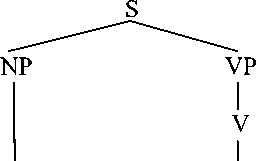
Wang Lung stopped
It can be seen from the structure in sentence pattern in datum 8 Wang Lung stopped that the simple sentence has the constituent structure of NP and VP. The VP consists of verb only. We can see from the constituent structure of Wang Lung stopped in datum 8 as follows:
S-------► NP VP
By looking at the tree diagram in datum 8 in the sentence Wang Lung stopped it can be seen from the text that unit shift occurred in the process of translation. A translation shift of a word into a phrase occurred in the translation process in datum 8. As a part of simple sentence, a word stopped was translated into a phrase berhenti melamun. The translation equivalent in the target language occurs at a different rank into a phrase berhenti melamun. This type of shift is called as unit shift that is a change in higher rank that was translated from a word stopped into a phrase berhenti melamun.
Datum 9
He passed into an animal satisfaction. (3)
Ia melepaskan dahaganya. (9)

NP VP
Pro V PP

P NP

He passed into an animal satisfaction
We can see from the structure in sentence pattern in datum 9 he passed into an animal satisfaction that the simple sentence has the constituent structure of NP and VP. The VP consists of verb and prepositional phrase. It can be seen from the constituent structure of he passed into an animal satisfaction in datum 9 as follows: S-------► NP VP
VP ------► V PP
PP -------► P NP
By looking at the analysis of the tree diagram in datum 9 in the simple sentence he passed into an animal satisfaction that unit shift occurred in the process of translation. A
translation shift of a word into a phrase occurred in the translation process in datum 9 from a translation of a phrase into a word. As a part of simple sentence, a phrase passed into was translated into a word melangkah. The translation equivalent in the target language occurs at a different rank into a word melangkah. This type of shift is called as unit shift that is a change in lower rank that was translated from a phrase passed into to a word melangkah.
The research study found that there were seven sentence patterns that were translated by applying unit shift and translation shift. The data were analyzed based on syntax analysis, types of sentences, sentence pattern, tree diagram, and relevant previous studies.
This research study focuses on analyzing the tree diagram structure and the types of translation shifts in translating from the source language into target language. The analysis applied the theory of sentence patterns proposed by Quirk and Greenbaum and the theory of translations shift that was proposed by Catford. The process of collecting data was started by reading the novel in order to understand the novel entitled “The Good Earth” and observe the data of sentence patterns from the data source. In the method of collecting data, the novel was read in order to find out data of complex sentences and simple sentence found in the novel. The research study found that there were seven sentence patterns that were translated by applying unit shift and structure shift. The data were analyzed based on syntax analysis, types of sentences, sentence pattern, tree diagram, and relevant previous studies. It can be seen for example in datum 8 in the sentence Wang Lung stopped that unit shift occurred in the process of translation. A translation shift of a word into a phrase was implied in the translation process in datum 8. As a part of simple sentence, a verb stopped was translated into a phrase berhenti melamun. The translation equivalent in the target language occurs at a different rank into a phrase berhenti melamun. This type of shift is called as unit shift that is a change in higher rank that was translated from a word stopped into a phrase berhenti melamun.
The highest appreciation is dedicated to university of bali dwipa denpasar, indonesia for the research funding and to all parties who support the research and its publication.
References
Bowler, J., Lilley, T. J., Pittam, J. D., & Wakeling, A. E. (1989). Novel steroidal pure
antiestrogens. Steroids, 54(1), 71-99. https://doi.org/10.1016/0039-128X(89)90076-7
Broccias, C. (2011). Motivating the flexibility of oriented–ly adverbs. Motivation in
Grammar and the Lexicon, 71-88.
Brown, K., Miller, J., & Miller, J. E. (1991). Syntax: a linguistic introduction to sentence structure. Psychology Press.
Catford, J. C. (1965). A linguistic theory of translation: An essay in applied linguistics.
Oxford University Press.
Doetjes, J. (2007). Adverbs and quantification: Degrees versus frequency. Lingua, 117(4), 685-720. https://doi.org/10.1016/j.lingua.2006.04.003
Ernst, T. (2007). On the role of semantics in a theory of adverb syntax. Lingua, 117(6), 1008
1033. https://doi.org/10.1016/j.lingua.2005.03.015
Guo, Z. Y., Li, D. Y., & Wang, B. X. (1998). A novel concept for convective heat transfer enhancement. International Journal of Heat and Mass Transfer, 41(14), 2221-2225. https://doi.org/10.1016/S0017-9310(97)00272-X
Haeberli, E., & Ingham, R. (2007). The position of negation and adverbs in Early Middle English. Lingua, 117(1), 1-25. https://doi.org/10.1016/j.lingua.2005.08.001
Halliday, M. A. K. (1985). An Introduction to Functional Grammar, Edward Arnold, London. Google Scholar.
Huddleston, R., & Pullum, G. K. (2005). A student's introduction to English grammar.
Cambridge University Press.
Huddleston, R., & Pullum, G. K. (2005). A student's introduction to English grammar. Cambridge University Press.
Ji, S. (2000). ‘Face’and polite verbal behaviors in Chinese culture. Journal of pragmatics, 32(7), 1059-1062. https://doi.org/10.1016/S0378-2166(99)00068-5
Juliarta, I. (2020). Verb Phrase and Its Translations Found in the Novel “Budha, a Story of Enlightenment”. IDEAS: Journal on English Language Teaching and Learning, Linguistics and Literature, 8(2), 505-518. doi:https://doi.org/10.24256/ideas.v8i2.1520
Johannessen, J. B. (2005). The syntax of correlative adverbs. Lingua, 115(4), 419-443.
https://doi.org/10.1016/j.lingua.2003.09.009
Pratama, P. B. (2015). The roles held by the suffix -mente in deriving spanish adjective with reference to adverb. International Journal of Linguistics, Literature and Culture, 1(1), 34-37.
Quirk, R., & Greenbaum, S. (1973). A concise grammar of contemporary English. Harcourt School.
Thomson, A. J., & Martinet, A. V. (1980). A practical English grammar. Oxford University Press.
Zhou, Q. B., Zhang, J., & Edelheim, J. R. (2013). Rethinking traditional Chinese culture: A consumer-based model regarding the authenticity of Chinese calligraphic landscape. Tourism Management, 36, 99-112. https://doi.org/10.1016/j.tourman.2012.11.008
Biography of Author
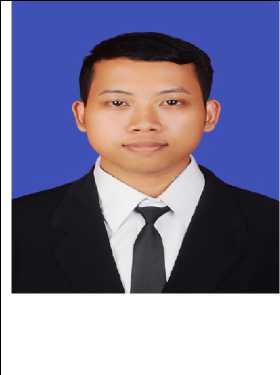
I Made Juliarta is an English Lecture at English Department, Bali Dwipa University. He completed his Master study program in Applied Linguistics – Translation Studies from Udayana University in 2016. He completed her Undergraduate study program in English Literature from English Department, Udaya University in 2013. His research interests in Linguistics include translation studies, semiotics and sociolinguistic studies.
Email: madejuliarta330@gmail.com
Discussion and feedback